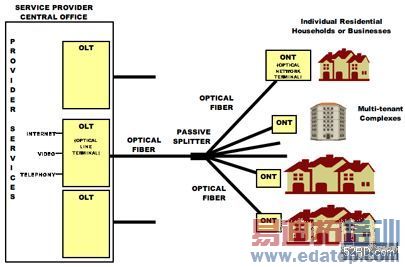- 易迪拓培训,专注于微波、射频、天线设计工程师的培养
千兆串行/解串器:PON 谜题的关键部分(英)
The recent barrage of such consumer and business-oriented electronics as high definition television, personal video players, network gaming, IP telephony, and video e-mail consoles are all being eyed by the consumer as must-have items. The key enabler for using all of these devices is greater network bandwidth. Consumers worldwide are now quickly filling their homes and workspaces with bandwidth-hogging electronics that need content in order to utilize them. Service providers and content owners want to provide the demanded services especially as these services represent the true growth component of their respective industries.
The main issue blocking service providers and content owners from fulfilling the demands of the bandwidth-hungry consumer is the antiquated copper communication links that connect the majority of today’s consumers to the communication grid. The existing copper infrastructure that connects most consumers and business users to the Internet, and communication grids in general, has reached its capacity in terms of the number of users it can service given all of the new bandwidth-intensive applications that consumers want to use.
Technologies such as xDSL and cable were able to provide copper networks with a much needed bandwidth boost at the start of the Internet era. Now, however, as consumers demand even more bandwidth for applications such as IP-TV and IP-telephony, copper networks simply do not have the bandwidth to meet these demands. The bandwidth situation is exacerbated by the fact that internet usage is becoming ubiquitous. Internet usage penetration rates, in terms of general population usage, are expected to rival those of the telephone and television. This is especially true as computers, televisions and telephones become interconnected.
The end result is that service providers and content owners cannot provide revenue-generating services that their customers demand. On the consumer side, consumers are hesitant to buy more bandwidth-hungry electronics without an outlet to fully utilize their investment. As you can see, the bandwidth issue has repercussions throughout the consumer electronics, computer systems, service provider and content (entertainment) industry’s.
A potential solution
One potential solution to this bandwidth problem that has come to the forefront is Passive Optical Networking technology (PON). PON is a high bandwidth optical point-to-multipoint data access technology that enables data communication using passive optical components such as splitters and Wave Division Multiplexers (WDM).
PON systems typically consist of an Optical Line Termination unit (OLT) which is connected to multiple Optical Networking Terminal units (ONT) at the subscriber (consumer) site. Typically, one OLT can service up to 32-64 ONTs.

PON technology has been available for some time, but only in the past few years have underlying technologies that make up PON become sufficiently cost-effective for widespread implementation. PON, from the service provider’s perspective, enables efficient use of fiber since one link from the central office can service between 32 and 64 subscribers units, depending on the flavor of PON implemented. This results in a lower cost per subscriber in terms of equipment and fiber installation costs.
In addition, passive components require little maintenance and have very low failure rates. These and other factors result in a reasonable cost of implementation for PON networks. Given the reasonable cost of implementation and the large amount of bandwidth that can be brought to the subscriber, service providers are considering PON as the potential replacement technology to the copper networks they use today.
The technology used to implement PON has evolved over the past few years to accommodate various market regions as well as evolving underlying technologies. Today there are three major PON implementation categories. Broadcast PON (BPON), Ethernet PON (EPON), and Gigabit PON (GPON). Each PON flavor has its distinct advantages and disadvantages.
BPON uses Automatic Transfer Services (ATM) at its data transport layer and tends to be preferred where legacy infrastructure already uses ATM. BPON is backed by the ITU-T G.983 standard. This flavor of PON supports asymmetrical data rates of 622mbps downstream and 155mbps upstream. BPON is capable of supporting up to 64 subscribers per OLT link and can support link spans up to 20km. Some of the advantages of BPON are FSAN compliancy, traffic management capability, and support for Quality of Services (QoS.)
One drawback of BPON is the need for three optical wavelengths: one downstream wavelength for voice and data, another downstream wavelength for video and one upstream wavelength for voice and data. BPON tends to be more costly in terms of implementation when compared to the other flavors of PON.
EPON uses Ethernet as the data transport layer and is compliant to the IEEE802.3ah standard. EPON supports symmetrical data rates up to 1.25Gbps. Ethernet compatibility and support for switched digital video makes EPON a great choice for developing regions where there is little or no existing legacy infrastructure. EPON allows for 32 time slots (32 ONT per OLT) and typically supports link spans up to 20km.
One of the key advantages of EPON is its high speed data transmission combined with switched digital video service capability. This is in contrast to higher cost implementations that require separate wavelengths for video support. Also, seamless interoperability with other Ethernet enabled devices is an inherent advantage of EPON. One disadvantage of EPON is that fewer subscribers can be serviced per an OLT link compared to BPON.
GPON can be considered a superset of BPON but with one important distinction. GPON is protocol agnostic. Therefore, it supports both Time-Division Multiplexing (TDM) and packet data. GPON is backed by the ITU-T G.984 standard. It supports asymmetrical data rates of up to 2.5Gbps downstream and up to 1.24Gbps upstream. GPON is capable of supporting link spans up to the 40km. Some of the advantages of GPON is its support of switched digital video and support for native TDM voice without having to add IP.
One drawback of GPON is its immaturity in comparison with BPON technology. This is likely to change over time since the benefits of GPON aligns nicely with what the end consumer demands. GPON is likely to see more initial installations in North America since BPON and ATM infrastructure is more prevalent in that region.
Critical implementation requirement
One of the critical implementation requirements for PON systems is the need for the ports on the OLT to continuously switch between multiple ONT subscribers. Typically ONTs are given 1 of 32 (or 1 of 64) available time slots to interact with the OLT. This requires the OLT to quickly lock to one ONT stream after another. This quick lock and re-lock cycle requirement is typically referred to as "burst mode" re-lock support (from the OLT perspective.).
In order to support this fast locking functionality, that is critical to PON implementation, specialized Media Access Control (MAC), Serialization/Deserialization (SerDes) and Clock and Data Recovery (CDR) silicon technologies are required. The MAC coordinates the access to each ONT as well as performs typical MAC functions.
SerDes a key piece of the puzzle
SerDes/CDR silicon plays a very important role in PON implementation as it is one of the keys to achieving fast re-lock functionality (at the OLT side.) Re-lock times of less than 30 bits time for GPON and less than 300 bits times for EPON are typically required. Exact re-lock times needed by any particular system implementation will depend on the system architecture as well as components used in the design.
Historically, GPON system makers have implemented the SerDes + CDR functionality discretely using multiple components such as CDRs, clock phase alignment units, muxes, de-muxes and shift registers. These discrete implementations were costly and very power hungry. In some cases, these discrete implementations lowered the overall cost effectiveness of the PON-based implementation.
However, recently silicon developers have introduced integrated SerDes solutions for both EPON and GPON systems. Devices for EPON applications and for GPON applications provide low cost and low power integrated SerDes solutions that support fast re-lock capability that is needed for PON (EPON and GPON.) For example, by integrating the mux, de-mux and CDR, a power dissipation of approximately 800mw is attainable. Comparative discrete solutions tend to have power dissipations numbers between 2-3 watts for comparable functionality. Also, since these devices are built with low cost Complementary Metal Oxide Semiconductor (CMOS) technology, not only are they applicable to OLT side designs, but also ONT application as well. ONT implementation requirements are typically less stringent in terms of re-lock time than for OLT side. However, ONT components need to be very cost effective since they are closer to being a consumer oriented system.
It is apparent that new SerDes designs that support critical PON requirements such as fast re-lock will be one of the keys to PON infrastructure build out. With advances in optical module, passive component, and silicon technologies, all of the pieces seem to be in place for PON to finally replace the 100+ year old copper access infrastructure.

